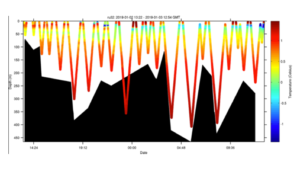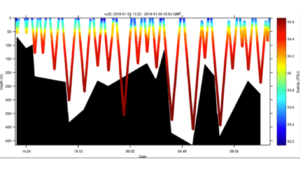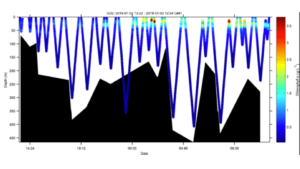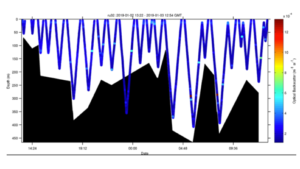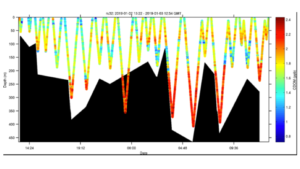-
Glider is launched offshore Palmer Station
Posted on January 3rd, 2019 No commentsWeather cooperated and the LTER team was able to launch a glider this Wednesday offshore Palmer Station. Hopefully the ice will cooperate and we maintain a sustained presence for the rest of the summer season. The glider this year is outfitted with a SeaBird CTD, WetLabs fluorometer and optical backscatter sensor. The glider is also carrying a ASL Environmental Sciences multifrequency acoustic system to measure zooplankton and fish. The goal of this years mission is to measure the variability of phytoplankton, zooplankton, and fish distributions and their relationship to penguins and whales. Currently the glider is transecting back and forth along the head of the Palmer Deep canyon. Below is the glider location along the WAP (A) and the a zoom-in showing its movements near palmer station over the last 24 hours (B).
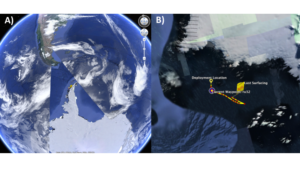
The figure below is the cross section of the water temperature. The black shapes is the “estimated sea floor” as measured by the onboard glider altimeter. The altimeter is obviously giving some false bottoms, as the glider is transecting deeper the altimeter derived sea floor. This has been seen before, and our working hypothesis is the altimeter is getting returns on large krill swarms not the seafloor. The AZFP will provide insight on this. Temperatures show a typical range for this location, with warm water at the surface (presumably reflecting radiant heating) and at depth reflecting remnant modified circumpolar deep water. A cooler layer at 30-50 meter water depth probably reflects residual cold surface water.
The salinity shows a fresher surface layer with a salinity at 33 to 33.2. This likely reflects sea ice and glacial melt.
Chlorophyll fluorescence shows a surface bloom at the eastern portion of the transect indicating a moderately sized phytoplankton bloom.
Optical backscatter shows no strong correlation with the surface phytoplankton. However there does appear to be particles at depth which could be consistent with export flux events with the material potentially ranging from marine snow to animal poop.
Finally Colored Dissolved Organic Matter (CDOM) shows significant variability, however the deep modified circumpolar deep waters are distinct with a high fraction of fluorescent CDOM.



